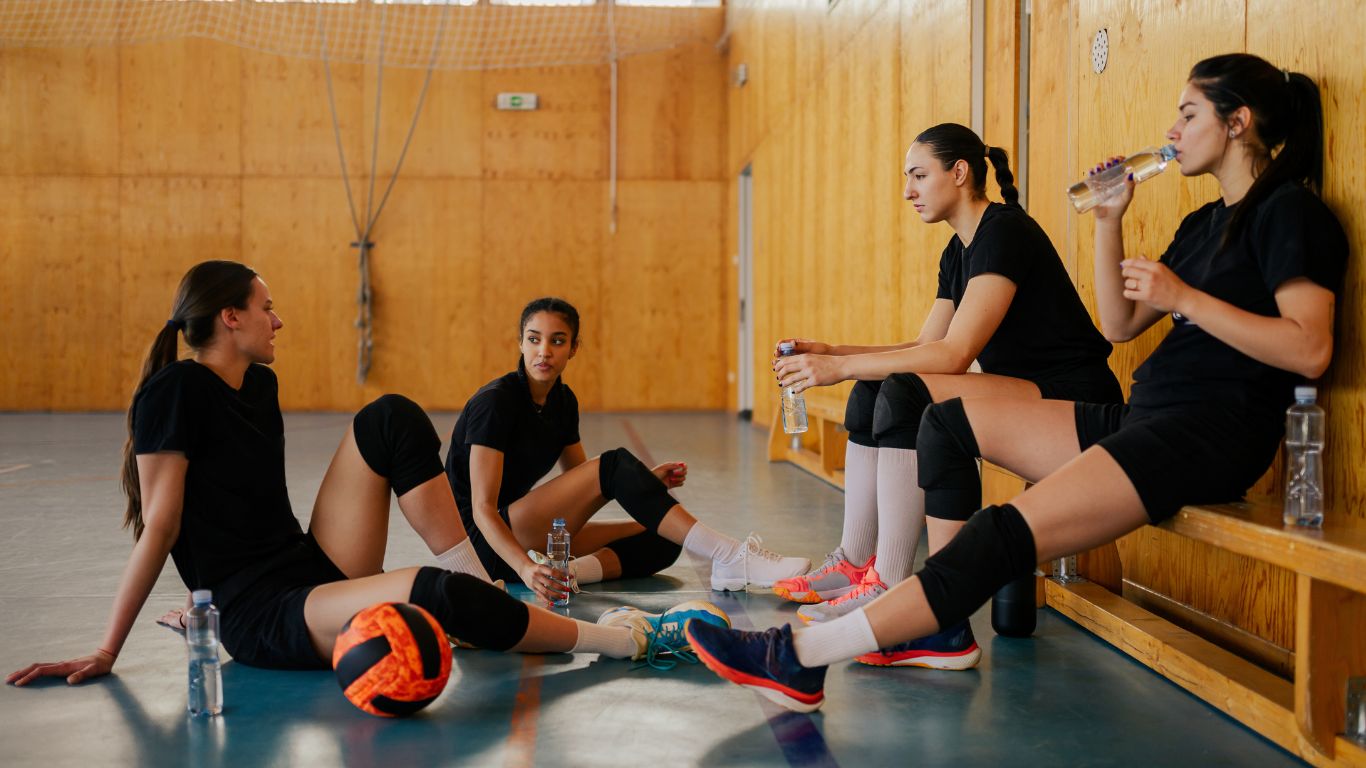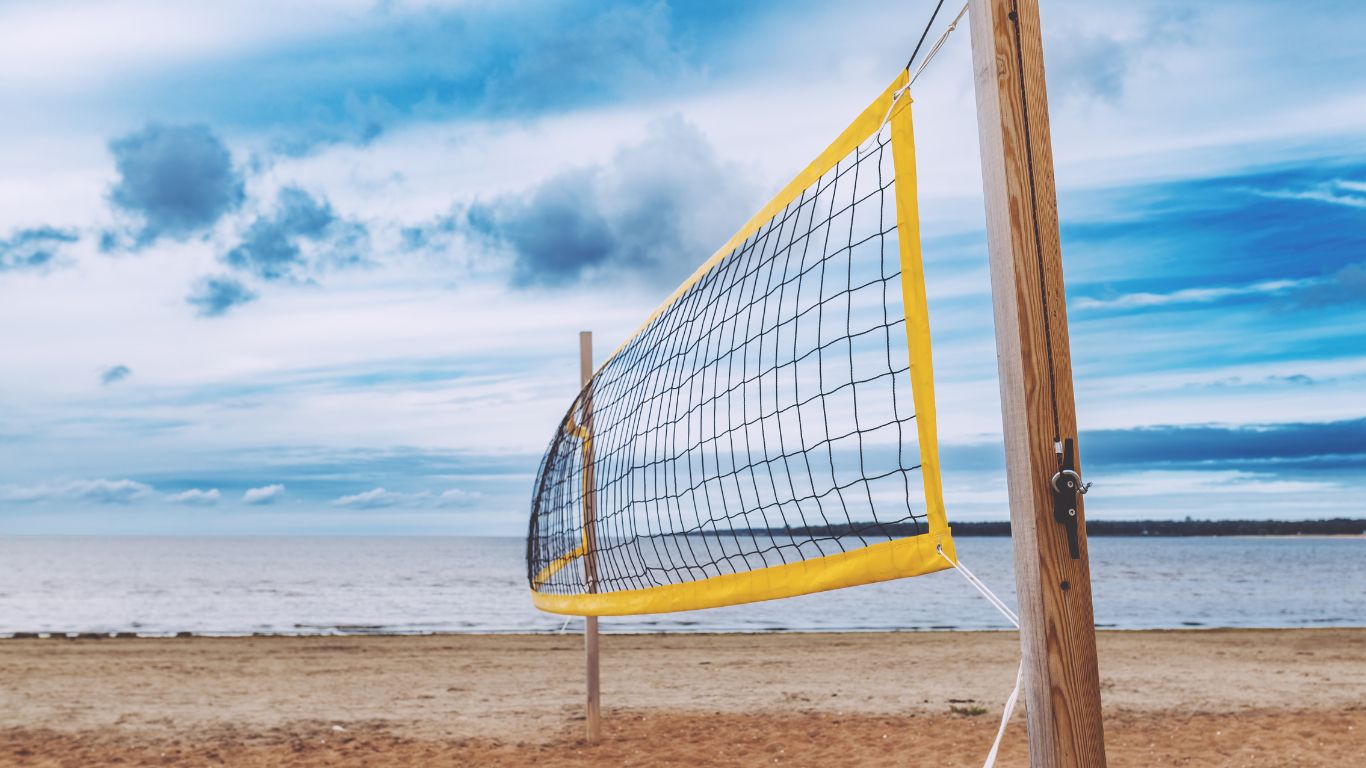To play volleyball, familiarize yourself with the rules and divide players into two teams who hit a ball back and forth over a net. Volleyball is a popular sport played by teams of six on a rectangular court.
The objective is to hit a ball over a net and land it within the opposing team’s court area while preventing them from doing the same. In order to play volleyball, you will need a net, a volleyball, and a court.
The game begins with a serve, in which the player hits the ball over the net from behind the back line. The opposing team must then return the ball before it hits the ground. The game continues with each team attempting to score points by hitting the ball over the net and making it unreturnable for the other team. Successful team coordination, communication, and strategic play are key to winning in volleyball.
The Basics Of Volleyball
If you’re looking to have some fun, boost your fitness, and make new friends, volleyball is the perfect sport for you. Whether you’re a beginner or an experienced player, understanding the basics of volleyball is essential for enjoying the game. In this blog post, we’ll cover the basic rules, court, and equipment you need to know in order to play volleyball like a pro!
Basic Rules
Before diving into the exciting world of volleyball, let’s first familiarize ourselves with the basic rules of the game:
- Teams: Volleyball is a team sport played with two teams, each consisting of six players on the court.
- Objective: The objective is to score points by hitting the ball over the net and making it land within the boundaries on the opposing team’s side.
- Serving: A player from the serving team starts the game by serving the ball from behind the back boundary line over the net to the opposite team’s court.
- Playing the ball: Each team has up to three hits to get the ball over the net. The common moves include the pass, set, and spike.
- Scoring: Points are awarded when the ball hits the ground within the boundaries of the opposing team’s court, or if the opposing team fails to return the ball properly.
- Side switching: Teams switch sides of the court after each set to ensure fairness due to varying conditions.
Court And Equipment
Now that we understand the basic rules, let’s get acquainted with the court and equipment used in volleyball:
The volleyball court is a rectangular playing area divided into two halves by a net. The court measures 30 feet wide and 60 feet long. The space above the court should have enough clearance to allow players to jump and spike the ball effectively.
Court Dimensions
Below is a table that provides a breakdown of the dimensions of a volleyball court:
| Length | Width | Height |
|---|---|---|
| 60 feet | 30 feet | Varies (as long as players have enough clearance to play) |
The equipment required for playing volleyball is minimal:
- Volleyball: A standard volleyball is used, which is light and has a circumference of around 25.6 inches.
- Net and poles: The net is centrally placed and horizontally stretched across the court, supported by two poles situated at each sideline.
- Court boundaries: The boundaries of the court are marked by lines, including the end lines and sidelines.
- Knee pads and appropriate footwear: To protect against injuries, it is advisable to wear knee pads and proper athletic shoes.
Now that we’ve covered the basics of volleyball, you’re ready to step onto the court and start playing. Remember to have fun, communicate with your teammates, and give your best effort. Happy playing!

Key Skills For Volleyball
Mastering key skills is essential for playing volleyball. From serving with precision to setting up perfect passes and delivering powerful spikes, these abilities are crucial for success on the court. Develop these skills to excel in the game.
Serving
Serving is the act of initiating play by sending the ball over the net to the opposing team. It is crucial to have a strong and accurate serve to gain an advantage in the game. There are different types of serves, such as the underhand serve, overhand serve, and jump serve. Each serve requires proper technique and precision.
Passing
Passing, also known as “bumping,” is the skill of receiving and redirecting the ball to a teammate who is in a better position to make a play. This skill is essential for maintaining control of the ball and starting offensive plays. Proper passing technique involves using your forearms to create a platform and keeping your eyes on the ball to ensure accurate passing.
Setting
Setting is the skill of accurately and precisely positioning the ball for a teammate to attack or make a play. It requires coordination and timing to create a perfect set. A good setter needs to have excellent hand-eye coordination, soft hands, and the ability to make split-second decisions. Setting plays a crucial role in offensive strategies and can greatly impact the outcome of a game.
Attacking
Attacking, also known as “spiking,” is the skill of hitting the ball towards the opposing team’s court with force and accuracy. It is a vital offensive weapon to score points. To execute a successful attack, a player needs to approach the net, time their jump, and hit the ball with the correct technique. This requires power, precision, and the ability to read the opposing team’s defense.
Blocking
Blocking is the skill of stopping or redirecting an attack from the opposing team. It involves jumping up at the net to intercept the ball as it crosses over from the opponent’s side. The goal of blocking is to disrupt the opposing team’s attack and create scoring opportunities. Effective blocking requires good timing, height, and the ability to read the opposing team’s hitters.
Digging
Digging is the skill of receiving and returning a hard-driven ball from the opposing team. It is crucial in defense to prevent the ball from hitting the floor on your side of the court. Proper technique such as using forearms or hands to handle the ball and maintaining a low, balanced stance is essential for successful digging. Quick reflexes and anticipation are key in this skill.
Understanding Positions
Understanding positions is crucial in learning how to play volleyball. By understanding the different positions and their roles, players can better coordinate and strategize within the game. Mastering positions helps create a strong team dynamic and enhances gameplay.
Understanding Positions In volleyball, understanding different player positions is crucial for a successful game. Whether you’re new to the sport or looking to advance your knowledge, grasping the roles of each position is fundamental. Let’s delve into the specifics of each key position on the volleyball court.
Setter
The setter is like the quarterback of a volleyball team, responsible for orchestrating the offense. This player is crucial in coordinating the team’s offensive strategies by setting up the hitters for successful attacks, making precise decisions, and distributing the ball effectively.
Outside Hitter
An outside hitter is usually the primary offensive weapon, often known for their powerful attacks from the left side of the court. They are essential for delivering powerful kills and maintaining strong offensive pressure on the opposing team.
Middle Blocker
The middle blocker is a defensive specialist, primarily positioned at the net to block the opponent’s attacking shots. Quick reflexes and effective blocking are key attributes of a proficient middle blocker, often serving as a vital defensive asset for the team.
Opposite Hitter
The opposite hitter is similar to the outside hitter but typically operates from the right side of the court. Their role includes contributing to the team’s offensive prowess, offering variety in attack options, and complementing the outside hitter to keep the opponents guessing.
Libero
The libero is a specialized defensive player equipped with exceptional digging and passing skills. Clad in a different jersey, the libero has the freedom to replace any back-row player without prior notification to the officials. Their expertise lies in keeping the ball in play and initiating the team’s defensive efforts. Understanding these pivotal positions in volleyball is a significant step toward grasping the dynamics of the game. Each player’s role harmonizes to create a cohesive team, highlighting the value of strategic gameplay and specialized skill sets.
Strategies And Tactics
When it comes to playing volleyball, having a solid strategy and implementing effective tactics can greatly enhance your performance on the court. Understanding offensive and defensive strategies, as well as game-winning tactics, can give you the edge over your opponents. In this section, we will explore these key elements of the game and provide you with valuable tips to elevate your skills.
Offensive Strategies
Offensive strategies in volleyball involve various techniques aimed at scoring points and putting pressure on the opposing team. Here are some key offensive strategies to consider:
- Setting up plays: Create a coordinated attack by strategically positioning your players on the court. This will allow for better communication and maximize your chances of executing successful plays.
- Communication: Effective communication is vital in offense. Use clear hand signals and verbal cues to coordinate your moves and confuse the defense. Quick, concise communication can help your team react swiftly and exploit gaps in the opposition’s defense.
- Varying your shots: To keep your opponents guessing, employ a mix of shots – from powerful spikes to precise tips and dinks. This will make it harder for the defense to anticipate your moves and ultimately increase your scoring opportunities.
- Exploiting weaknesses: Analyze the opposing team’s defense and identify their weaknesses. Target these areas by directing your attacks to exploit the gaps. This strategic approach will put additional pressure on the defense, leading to increased scoring chances.
Defensive Strategies
Defensive strategies are crucial for preventing the opposing team from scoring points. A strong defense can turn the tides in your favor. Consider implementing the following defensive strategies:
- Anticipating the opponent: Observe the opposing team’s patterns, such as their preferred shots or go-to players. By analyzing their tendencies, you can better anticipate their moves and position yourself to successfully block or dig their attacks.
- Quick reactions: Develop quick reflexes to react swiftly to the opponent’s shots. Practice your footwork and agility, enabling you to quickly adjust your positioning and efficiently defend against incoming attacks.
- Blocking: Blocking is a crucial aspect of defense in volleyball. Work on your timing, positioning, and technique to effectively block the opponent’s spikes. A well-executed block can disrupt the opponent’s offense and provide your team with an advantage.
- Teamwork: Effective defense requires strong teamwork and communication. Coordinate with your teammates to cover the court efficiently and ensure there are no gaps in your defense. By working together seamlessly, you can create a solid defensive line that is difficult to penetrate.
Game-winning Tactics
In addition to strategizing your offense and defense, game-winning tactics can help you secure victories. Implement these tactics during critical moments of the game to gain a competitive edge:
- Change of pace: Vary the speed and tempo of your team’s play to keep the opposition off balance. Mix up fast-paced attacks with slower, more controlled plays to catch the defense off guard and create scoring opportunities.
- Capitalizing on mistakes: Stay alert and ready to capitalize on any mistakes made by the opposing team. Whether it’s a mishit, poor communication, or a weak return, seize the moment and turn their errors into points for your team.
- Adapting to the situation: Be adaptable and adjust your tactics based on the game’s flow. Assess your opponent’s strengths and weaknesses as the match progresses and make strategic decisions accordingly. Flexibility and quick thinking are key to overcome challenges and secure victories.
- Mental fortitude: Maintain a positive mindset throughout the game, even when facing adversity. Stay focused, resilient, and supportive of your teammates. A strong mental game can help you overcome setbacks and rally your team to victory.
Mastering Volleyball Techniques
Mastering volleyball techniques is essential for becoming a skilled player. It requires practice, dedication, and a deep understanding of the game. In this section, we will explore three important techniques that every volleyball player should master: the Jump Serve Technique, Diving and Rolling Techniques, and the Quick Set Technique.
Jump Serve Technique
The jump serve is a powerful serving technique that can catch your opponents off guard and give your team an advantage. To perform a successful jump serve, follow these steps:
- Start by positioning yourself behind the baseline with your non-dominant foot slightly in front.
- Toss the ball high in the air, in line with your hitting shoulder.
- Run towards the ball, keeping your eye on it at all times.
- As the ball reaches its peak, jump off both feet and extend your hitting arm to strike the ball with the heel of your hand.
- Flick your wrist and follow through with your arm to generate topspin on the ball.
- Land balanced and ready to quickly transition into your defensive position.
Mastering the jump serve technique requires practice and coordination. It is essential to maintain a consistent toss and timing to achieve optimal power and accuracy.
Diving And Rolling Techniques
Diving and rolling techniques are crucial for keeping the ball in play and preventing it from hitting the ground. Here are some key points to remember:
- When diving, extend your arms in front of you, positioning your body parallel to the ground.
- Tuck your chin to protect your head and roll onto your shoulder, keeping momentum to minimize impact.
- Rolling techniques allow you to quickly recover and get back up on your feet.
- To roll properly, tuck your chin, roll diagonally, and maintain a tight body position.
- Practice diving and rolling drills to improve your reflexes and body control.
Remember, diving and rolling take practice and repetition to become natural movements. These techniques are essential for making spectacular defensive plays on the volleyball court.
Quick Set Technique
The quick set technique is a key skill for setters in volleyball. It involves quickly and accurately setting the ball for your teammates to attack. Follow these steps to master the quick set technique:
- Start by positioning yourself in a balanced stance, with your feet shoulder-width apart.
- As the ball is passed to you, move to the ball using quick footwork.
- Extend your hands above your forehead, with your fingers spread out and your thumbs pointing backward.
- Using your wrists and fingers, push the ball upward and forward, creating a high and quick trajectory.
- Aim to place the ball precisely where your attacker can easily approach and hit it.
Mastering the quick set technique requires precise hand-eye coordination, timing, and understanding the strengths and preferences of your attackers.

Fitness And Conditioning For Volleyball
Playing volleyball requires a high level of physical fitness and conditioning. Fitness and conditioning are crucial for performing well on the court, and they can help prevent injuries. In this post, we’ll delve into the key aspects of fitness and conditioning that are vital for volleyball players.
Strength Training3
Strength training is essential for volleyball players to build power and stability. By focusing on exercises that target the core, upper body, and lower body, players can strengthen the muscles necessary for spiking, digging, and blocking. Incorporating weightlifting, bodyweight exercises, and resistance training can help enhance overall strength.
Cardiovascular Conditioning
Cardiovascular conditioning is vital as volleyball is a fast-paced sport requiring bursts of energy and endurance. Engaging in activities such as running, cycling, and interval training can improve players’ cardiovascular fitness, enabling them to perform at their peak throughout a game.
Flexibility And Agility
Flexibility and agility are essential for quick movements and swift changes in direction on the volleyball court. Implementing stretches, yoga, and drills focusing on agility and footwork can enhance players’ flexibility and nimbleness, supporting their overall performance.

Frequently Asked Questions
How Do You Play The Game Of Volleyball?
To play volleyball, you need a team of six players. The objective is to hit the ball over the net to the opposing team’s side. Each team has three hits to get the ball over the net. The game continues until one team fails to return the ball.
What Are Basic Volleyball Rules?
Volleyball rules include six players on each team, with three hits allowed per side and no catching or holding the ball. The game continues until one team reaches 25 points, with a two-point lead. A rally scoring system is used, with points awarded on every play.
How Should A Beginner Start Playing Volleyball?
To start playing volleyball as a beginner: 1. Learn the basic rules and positions. 2. Practice basic skills like serving, setting, and hitting. 3. Join a recreational league or find a local group to play with. 4. Focus on improving your technique and fitness level.
5. Watch and learn from experienced players to enhance your game.
What Are The Basic Steps Of Volleyball?
The basic steps of volleyball include serving, passing, setting, attacking, and blocking. These steps require coordination, teamwork, and agility. Serving starts the game, passing and setting keep the ball in play, attacking scores points, and blocking defends against the opponent’s attack.
Conclusion
Mastering the art of playing volleyball requires practice, teamwork, and skill development. By understanding the basic techniques, honing your strategy, and staying committed to improvement, you can elevate your game both mentally and physically. With these insights, you can step onto the court with confidence and passion, ready to embrace the challenges and joys of volleyball.








